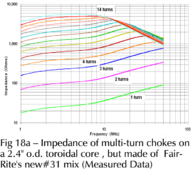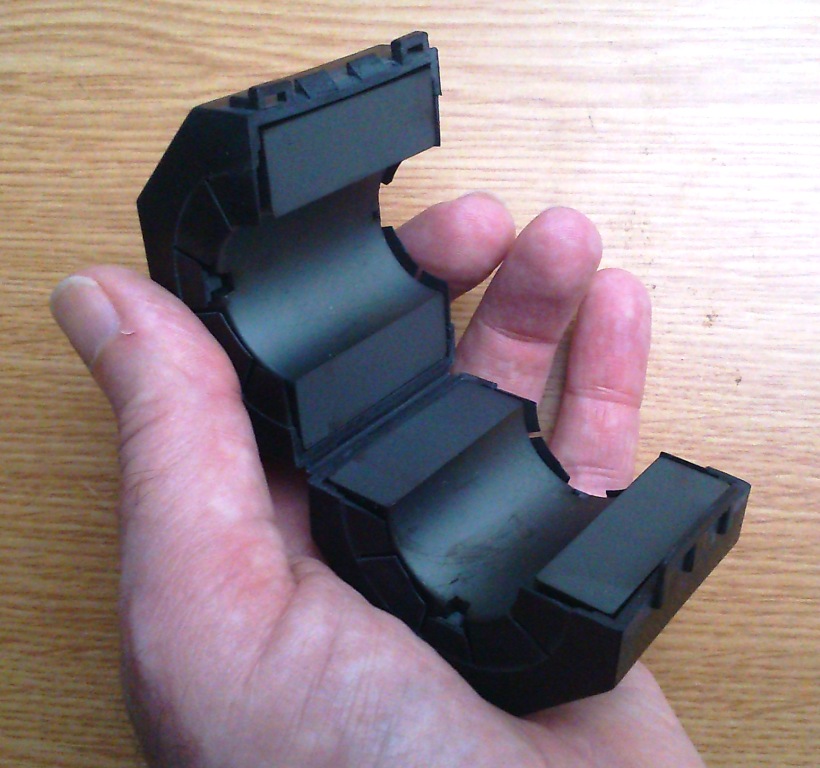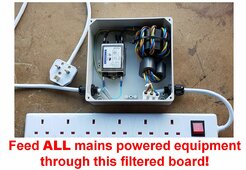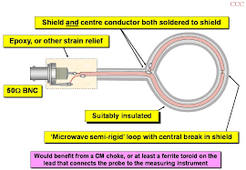Nice job guys ! Taming RFI is often a tedious and difficult job.
Here is a good reference piece from Jim, K9YC for anyone interested :
Here is a good reference piece from Jim, K9YC for anyone interested :
It is not a "Cheap" inverter thing, it happens with Sol-Arks and other expensive brands.

Nice job guys ! Taming RFI is often a tedious and difficult job.
Here is a good reference piece from Jim, K9YC for anyone interested :
From the link above. Looks like 14 turns on 1 core is optimal for attenuation between 2 - 10 Mhz. In my experience trying to attenuate RFI from Victron MPPT, stacking more cores made things better. But it's clear how winding capacitive coupling takes over > 10 Mhz with too many turns. Would be interesting to measure it with 30 turns. Would probably have around 10Kohm impedance but at narrow freq. range around 2MHz and steep roll off at freqs above.
I don't think it would matter at RF. C5 is there to couple neutral to ground when bond is open.In your proposition, what about the bond between neutral and earth in offgrid mode ? C5 cap would be shorted: could it create imbalance ?
Only if you've tuned your array to be resonant on a particular band and are using it for an antenna. 8*)Maybe we need to have a DIY ham net some time when the bands are great.


Good luck for 160 m hahaOnly if you've tuned your array to be resonant on a particular band and are using it for an antenna. 8*)
Just need a big array. Win/Win!Good luck for 160 m haha
That line filter most likely cleans up differential mode RFI followed by ferrite to choke common mode.I found a link and I noticed the guy put the LC filter before the toroids (he ie using type 31 and type 43). I wonder if that matters.
Ah, now that I think about it, the MPPT is going to be differential mode, so common mode chokes aren’t going to help a lot.Additionally, paralleling the Mix31 cores physically from each wire together, further reduced it.
Here is the new way:
View attachment 208374
Note that I removed the ground from the inverter because I needed to bond the neutral to the ground anyway in offgrid mode, which I do with a relay) :
Filter at ground
View attachment 208376
Ah, now that I think about it, the MPPT is going to be differential mode, so common mode chokes aren’t going to help a lot.
I don't think you know which wires are the radiator.
Have a sniffer probe or clamp current probe good for the frequency of interest? Check for common-mode and differential mode on each cable/wire.

Non-isolated from AC. Low frequency 50Hz commutating half-bridge of DC-AC inverter stage connects N wire to positive internal HVDC rail and on alternate half cycle to negative rail. When it connects positive to neutral it causes PV- to become negatively biased in relation to ground by HVDC voltage typically -450V.The square wave you mention, is that MPPT or is it due to non-isolated from AC?


